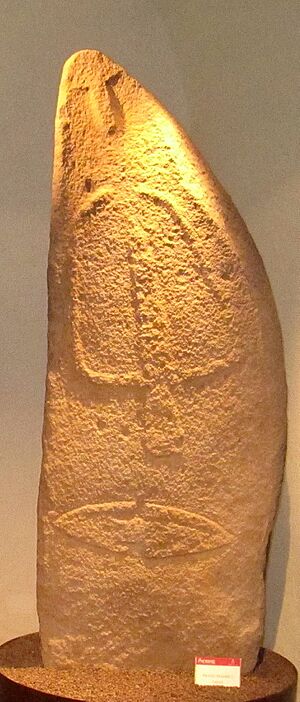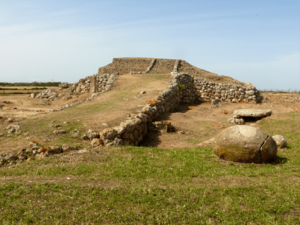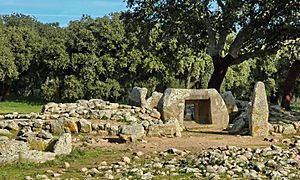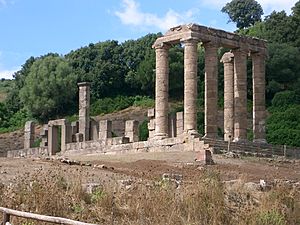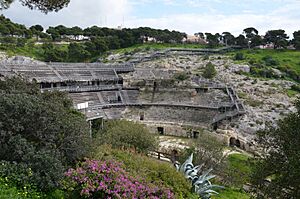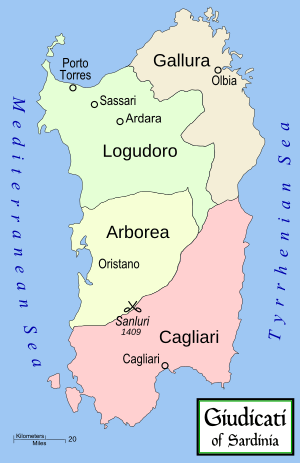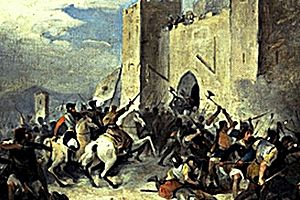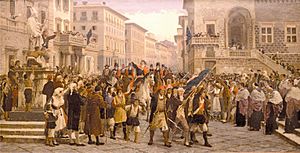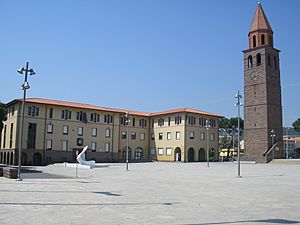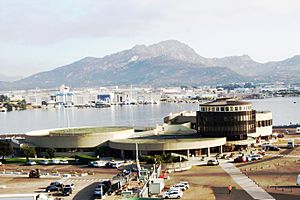History of Sardinia facts for kids
The island of Sardinia has a very long and interesting history! We know people lived here in prehistoric times because of amazing stone structures called nuraghes and other ancient monuments. The recorded history of Sardinia truly begins when different groups like the Phoenicians, Punics (from Carthage), and Romans came to control trade in the western Mediterranean Sea.
Sardinia first had strong ties with Phoenician cities. Later, it was partly taken over by Carthage around 500 BC. Then, after the First Punic War, the Romans fully conquered the island in 238 BC. For many centuries, Sardinia was a Roman province called Sardinia and Corsica.
In the Early Middle Ages, as the Byzantine Empire became weaker and Saracen raiders attacked, Sardinia became independent. This led to the creation of four independent kingdoms called Judicates between the 8th and 10th centuries. Later, the Crown of Aragon took over the island in 1324, forming the Kingdom of Sardinia. This kingdom lasted until 1718, when it was given to the House of Savoy. The Savoy family, from Piedmont, eventually expanded their rule to the rest of Italy. Their Kingdom of Sardinia was renamed the "Kingdom of Italy" in 1861.
Ancient Times
Life Before the Nuraghes
The very first signs of human-like creatures in Sardinia date back 8.5 million years! In 1996, a finger bone from a very early human, about 250,000 years old, was found in a cave.
Modern humans arrived on the island during the Upper Paleolithic period. A bone from a finger, found in the Corbeddu Cave, is about 18,000 years old. People also lived in Sardinia during the Mesolithic period, with remains found in caves like Su Coloru.
During the Stone Age, a mountain called Monte Arci was very important. It was a main source of obsidian, a volcanic glass used to make sharp tools and arrowheads. You can still find pieces of it there today!
The Neolithic period began in Sardinia around 6000 BC with the Cardial culture. Later, other important cultures developed, like the Ozieri culture and the Arzachena culture. During these times, huge stone monuments called megaliths started appearing.
Around 3000 BC, the dolmen culture arrived, bringing new ideas from Western Europe. These included the famous Bell Beaker pottery.
Sardinia's landscape is dotted with amazing prehistoric monuments. These include the Domus de Janas (which means "House of the Fairies" or "House of the Witches"), tall standing stones called menhirs and Statue menhirs, and stone tables known as dolmens.
Timeline of Early Sardinian Cultures
Here are some of the main archaeological cultures in Sardinia before the Nuragic period:
| Culture Name | Years Before Christ |
|---|---|
| Cardium pottery or Filiestru culture | 6000–4000 |
| Bonu Ighinu culture | 4000–3400 |
| San Ciriaco culture | 3400–3200 |
| Ozieri culture | 3200–2700 |
| Abealzu-Filigosa culture | 2700–2400 |
| Monte Claro culture | 2400–2100 |
| Bell Beaker culture | 2100–1800 |
| Bonnanaro culture (Phase A) | 1800–1600 |
The Nuragic Period
The Bronze Age in Sardinia is famous for its unique stone structures called nuraghes. There are more than 8,000 of these towers all over the island! The most well-known is the complex of Barumini. Most nuraghes were built between 1800 and 1200 BC, but many were still used even during Roman times. Other important structures from this period include holy well temples, megara temples, and Giants' graves (large tombs).
The Nuragic people also created beautiful bronze statues and the impressive "giants of Mont'e Prama." These might be some of the first human-like statues in Europe!
We know that the ancient Sardinians traded with the Mycenaeans from Greece. Pottery found in Sardinia shows clear connections with powerful cities like Kydonia in Crete. Some scholars believe the Sardinians might be linked to the Sherden, a group of "sea peoples" who invaded Egypt. However, this idea is still debated by historians.
The island's name might come from Sardus, a mythical hero of the Nuragic people.
Phoenicians and Carthaginians
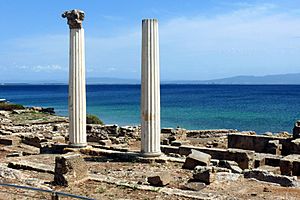
Starting in the 8th century BC, the Phoenicians began to build cities and strongholds in Sardinia. They chose strategic spots, often peninsulas or islands near rivers, which were easy to defend and had natural harbors. Some of these cities were Tharros, Bithia, Sulci, Nora, and Caralis (modern Cagliari). Most people living in these cities were native Nuragic Sardinians, but the Phoenician culture became very important.
The Phoenicians came from what is now Lebanon. They created a huge trading network across the Mediterranean Sea. Sardinia was special because it was right in the middle of the western Mediterranean, between Carthage, Spain, and the Etruscan civilization area. The Iglesiente region was important for its lead and zinc mines.
Around 510 BC, the Carthaginians took control from the Phoenicians. They expanded their influence along the western and southern coasts, from Bosa to Caralis. They strengthened existing Phoenician cities and built new ones like Olbia and Cornus. Tharros likely became the capital of their province. Carthage focused on growing grain and cereals on the island.
Today, places like Tharros, Nora, and Bithia are important archaeological sites where you can see ancient buildings and city layouts.
Roman Rule
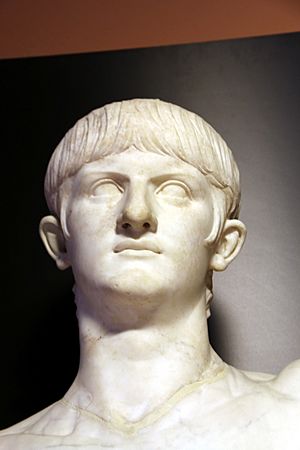
In 240 BC, during the First Punic War, Carthaginian soldiers on Sardinia rebelled. This gave the Romans a chance to land on the island and take it over. By 238 BC, the Romans controlled all of Sardinia without a fight. They took over the existing cities and systems. Sardinia, along with Corsica, became a Roman province. It was a major source of grain for Rome until Egypt was conquered.
Some Sardinians tried to rebel against Roman rule. A big revolt happened in 216 BC, led by Hampsicora and Hanno. The Romans sent a large army and defeated them in a major battle, killing many. Another large revolt was put down by Tiberius Gracchus in 177-176 BC. Even so, Sardinians living in the rugged mountains of the interior continued to resist Roman control for a long time.
Punic culture stayed strong for the first few centuries of Roman rule. But over time, the island became more "Romanized." Latin became the main language, eventually developing into the modern Sardinian language. The Roman religion also spread. Important cities like Caralis (Cagliari), Nora, and Sulci became Roman Municipia (towns with Roman rights). A new Roman colony called Turris Libissonis (Porto Torres) was founded in the north. The Romans also built four major roads connecting the main cities.
In 212 AD, all free people in the Roman Empire became Roman citizens. This included many islanders from the cities. Around 286 AD, Sardinia became part of the Italian region of the Roman Empire. It remained under Roman control until the Vandals conquered it in 456 AD.
Vandals, Goths, and Byzantines
After the Western Roman Empire fell, Sardinia was conquered several times. In 456 AD, the Vandals, a Germanic tribe from North Africa, took over the coastal cities. They were Arian Christians and even sent some African bishops to the island.
In 533 AD, the Vandal governor of Sardinia, Godas, rebelled and declared himself king. He asked the Byzantine Empire for help. The Byzantines sent forces, and the Vandals in Sardinia quickly surrendered. From then on, Sardinia was part of the Byzantine Empire. The local governor lived in Caralis. During the Gothic Wars, parts of the island were taken by the Ostrogoths, but the Byzantines eventually regained full control.
One famous Sardinian from this time was Ospitone, a leader from the central region of Barbagia. According to letters from Pope Gregory I, some parts of the island were Romanized and Christian, while people in the interior, like Ospitone's group, were still pagan or semi-pagan. Ospitone became Christian in 594 AD. Christianity on the island was strongly influenced by Eastern and Byzantine culture.
Two other important religious figures from Sardinia during this period were Pope Hilarius and Pope Symmachus.
Middle Ages
Saracen Attacks
Starting around 705 AD, Saracens (Arab armies) from North Africa began attacking the coastal cities of Sardinia. Because of these attacks, many coastal towns were abandoned. For example, in the 9th century, Tharros was left after 1,800 years of people living there, and its residents moved to Oristano. Caralis was also abandoned for a safer inland location called Santa Igia.
In 1015-16, a large Saracen fleet from the Balearics tried to invade Sardinia. But the Sardinian Judicates, with help from the navies of Pisa and Genoa, stopped the invasion.
The Judicates: Independent Kingdoms
Around the mid-11th century, four independent kingdoms called Judicates appeared in Sardinia. The title of Judex (judge) came from the Byzantine governors. In the 8th and 9th centuries, the four areas of Sardinia became more and more independent as the Byzantine Empire lost control of the Tyrrhenian Sea. A letter from Pope Nicholas I in 864 first mentioned the Sardinian judges, and later, Pope John VIII called them "Princes." Even Mieszko I of Poland knew about the Judicates, showing they were important in Medieval Europe.
During this time, Sardinia had about 300,000 people. The local administrators, called curators, reported to the judge, who also handled justice and led the army. The Church was also very powerful. In the late 11th century, monks from Italy and France arrived, helping to improve farming on the island. Old records from monasteries, called condaghes, tell us a lot about the island and its language in the 11th and 12th centuries.
There were four main Judicates: Logudoro (or Torres), Cagliari (or Pluminos), Arborea, and Gallura. Sometimes, some of them were united.
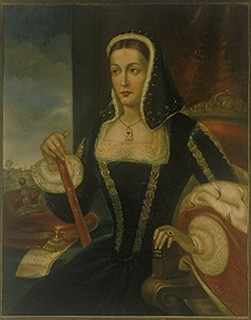
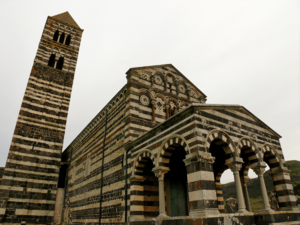
The Judicates often fought among themselves. They also made many trade deals with the cities of Pisa and Genoa. Soon, these powerful Italian maritime republics became very influential in Sardinia's economy.
By the late 12th and early 13th centuries, all four Judicates came under the rule of foreign families. Arborea passed to the Catalan House of Cervera in 1185. Cagliari was conquered by the House of Massa from Pisa in 1188. Gallura became a possession of the Visconti family from Pisa in 1207. Only Logudoro remained under local Sardinian rulers for a while, but it eventually passed to Genoa in 1259.
Around the same time, the city of Sassari declared itself a free city allied with Genoa. By the early 14th century, much of eastern and southern Sardinia was controlled by Pisa. However, Arborea remained the only independent Sardinian kingdom until 1420. One of the most famous Sardinian figures from the Middle Ages was Eleanor of Arborea. She was a co-ruler in the late 14th century and created a set of laws called the Carta de Logu, which were used for centuries.
Kingdom of Sardinia
Under Aragon and Spain
In 1323, an Aragonese army, led by Alfonso, landed in southern Sardinia. After defeating the Pisans, the Aragonese took control of the island. The Kingdom of Sardinia was officially created by Pope Boniface VIII in 1297 and became part of the Crown of Aragon.
In 1353, Marianus IV of Arborea started a war against the Aragonese. He took control of much of the island but couldn't capture Cagliari. A peace treaty was signed in 1355, but fighting started again in 1365. Arborea, led by Marianus IV and later by Brancaleone Doria, managed to capture most of the island. However, in 1409, the Aragonese defeated a Genoese fleet and crushed the Arborean army at the Battle of Sanluri. Oristano, the capital of Arborea, fell in 1410. The last Judge of Arborea, William II of Narbonne, sold his remaining lands to the Aragonese in 1420 for a large sum of money.

Losing independence and being ruled by Aragon (and later Spain from 1479) led to a decline in Sardinia. A system called feudalism was introduced, and the discovery of the Americas shifted trade routes away from the Mediterranean. In the 1470s, a revolt against the Aragonese was led by Leonardo Alagon, but it was eventually crushed. Constant attacks from North African pirates and several outbreaks of plague also made things worse.
In 1527, a French army attacked northern Sardinia, sacking towns like Sorso and Sassari.
In 1566, the first printing press in Sardinia was set up in Cagliari. Universities were founded in Cagliari (1607) and Sassari (1617).
In the late 15th and early 16th centuries, the Spanish built watchtowers all along the coast to protect the island from Ottoman attacks. In 1637, a French fleet sacked Oristano for about a week.
Under the House of Savoy
Sardinia was fought over between 1700 and 1720. After the War of the Spanish Succession, it was given to Emperor Charles VI in 1714. Spain briefly took it back in 1717, but in 1720, European powers gave Sicily to Charles VI and Sardinia to the House of Savoy. So, Vittorio Amedeo II became the King of Sardinia.
In 1793, Sardinians successfully defended their island twice against French invaders. On February 23, 1793, Domenico Millelire, leading the Sardinian fleet, defeated the French navy, which included the young Napoleon Bonaparte. Millelire received a high military honor. In the same month, Sardinians stopped a French landing near Cagliari.
Because of these victories, Sardinian leaders asked King Victor Amadeus III of Sardinia for equal rights with people on the Italian mainland. But the King refused. This led to an uprising in Cagliari on April 28, 1794, known as the "Vespri sardi" (Sardinian Vespers). Piedmontese officials were expelled from the capital for a few days. The revolt spread across the island, with people demanding an end to feudalism. A Sardinian magistrate named Giovanni Maria Angioy was appointed to help, but he eventually fled to Paris to seek French support for an independent Sardinia.
In 1799, King Charles Emmanuel IV was forced out of Piedmont by the French army and moved his court to Cagliari. He returned to Turin only in 1814. The Universities of Sassari and Cagliari were also restored around this time.
In 1820, the Savoy rulers introduced the "Enclosures Act" (editto delle chiudende). This law changed Sardinia's traditional system of shared land into private property. This caused many problems, as it helped landowners but hurt poor farmers and shepherds who lost their rights to communal land. Many local rebellions, like the Su Connottu riot in Nuoro in 1868, tried to bring back the old ways but were put down by the King's army.

In 1847, under King Charles Albert, Sardinia became fully integrated with the Italian mainland. All administrative differences were removed. This was called the "Perfect Fusion" and aimed to give equal rights to everyone in the Kingdom. This also laid the groundwork for the future united Italy.
New towns and urban plans were developed between the 18th and 19th centuries, often following the style of Turin. New roads and other structures were built under King Carlo Felice. The main road from Cagliari in the south to Sassari in the north was improved and is still named after Carlo Felice today. The first ferry route between Sardinia and Genoa was also started. The first railway opened in 1871.
The economy mainly focused on farming, sheep herding, and mining. Most mining companies were owned by people from outside Sardinia. However, in 1848, Sardinian businessman Giovanni Antonio Sanna bought the Montevecchio mine and became one of the richest men in the Kingdom.
United Italy
The Kingdom of Italy
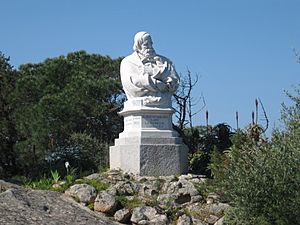
During this time, many Sardinian forests were cut down to provide wood for railways on the mainland. The amount of natural forest on the island greatly decreased.
When Italy was unified in 1861, the Kingdom of Sardinia became the Kingdom of Italy. In 1855, the national hero Giuseppe Garibaldi bought most of the island of Caprera, where he lived. His house, farm, and tomb are now the most visited museum in Sardinia.
In 1883, the first train traveled between Cagliari and Sassari. Many modern public works, like roads, dams, schools, and sewers, were built, mainly in the cities.
During World War I, Sardinian soldiers from the Brigata Sassari fought bravely and received many honors. After the war, some ex-soldiers formed a Sardinian nationalist movement, the Sardinian Action Party, but it was later banned. In 1924, the Italian Parliament passed a law to invest a lot of money (one billion lire) to develop Sardinia's infrastructure. However, only some of the money was actually used, mostly in Cagliari.
The famous Sardinian writer Grazia Deledda won the Nobel Prize for Literature in 1926.
During the Fascist period, many swamps on the island were drained, and new farming communities were created. These included Mussolinia (now called Arborea), settled by people from other parts of Italy, and Fertilia, near Alghero. The city of Carbonia was also built to be a major mining center. These projects brought many new settlers and immigrants to Sardinia.
The Fascist government was harsh on its opponents. Rural Sardinia showed little interest in Fascism, but some city people supported it. Antonio Gramsci, a founder of the Italian Communist Party, was arrested and died in prison. An anarchist named Michele Schirru was executed for trying to assassinate Benito Mussolini.
During World War II, Sardinia was bombed. From 1940, the Axis powers used its airfields for attacks. From 1943, the Allies bombed the island, heavily damaging cities like Cagliari and Alghero. German troops were stationed on Sardinia. In summer 1943, the Allies carried out fake attacks on Sardinia to trick the Axis into thinking they would invade there instead of Sicily. This plan worked!
The war ended in Sardinia in September 1943, when German troops left for Corsica after Italy surrendered to the Allies. Allied forces landed on Sardinia on September 14, 1943.
Italian Republic and Sardinian Autonomy
In 1946, more than 60% of Sardinians voted to keep the monarchy, but Italy became a Republic a few days later. In 1948, Sardinia gained the status of an autonomous region. This gave the island a high degree of self-governance, the most since the Judicates era. The first regional elections were held in 1949. By 1951, malaria was successfully eliminated with help from the Rockefeller Foundation.
In the same years, the "Italian economic miracle" led to a huge increase in tourism in Sardinia, especially for beach holidays and luxury tourism, like in Costa Smeralda. Today, about ten million people visit the island every year.
As tourism grew, coal mining became less important. After World War II, a big effort was made to industrialize Sardinia, called the "Piani di Rinascita" (Rebirth Plans). This included building new dams, roads, and large industrial factories, especially for oil. However, these efforts often failed to create many jobs because transportation costs were too high. In the 1950s and 1960s, many Sardinians moved to northern Italy and other parts of Europe for work.
In the early 1960s, with new petrochemical industries, thousands of former farmers became skilled workers. Others started working at new military bases, mainly for NATO. Even today, about 60% of all Italian and US military bases in Italy are in Sardinia. There have been protests about the environmental damage caused by military activities.
Since 1973, the international oil crisis caused many workers in the petrochemical industry to lose their jobs. Because of these failed industrialization plans, Sardinia is now one of the most polluted regions in Italy.
Economic problems and unemployment led to an increase in crime, including kidnappings. Between the 1970s and early 1980s, some communist and nationalist groups carried out terrorist attacks.
In 1983, for the first time, a member of a nationalist party, the Sardinian Action Party, was elected president of the regional parliament. In the 1990s, more radical pro-independence movements also emerged. In 1999, after a long period of Italian influence, the native languages of Sardinia were finally recognized as "historical language minorities" and given official status alongside Italian.
Today, Sardinia's coastal regions, like La Maddalena and Costa Smeralda, are very popular for tourism because they are easy to reach by ship and plane. Sardinia is now a region of the European Union with a diverse economy, mainly focused on tourism and services. Efforts in recent years have helped reduce the challenges of being an island, for example, with low-cost airlines and new information technologies. The CRS4 (Center for Advanced Studies, Research and Development in Sardinia) developed the first Italian website and invented webmail in 1995, leading to the creation of several telecommunication companies on the island.
|
See also
 In Spanish: Historia de Cerdeña para niños
In Spanish: Historia de Cerdeña para niños
- History of mining in Sardinia
- History of the Jews in Sardinia
- List of Nuragic tribes


